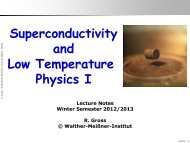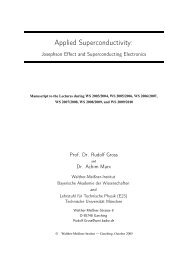Design, Fabrication and Characterization of a Microwave Resonator ...
Design, Fabrication and Characterization of a Microwave Resonator ...
Design, Fabrication and Characterization of a Microwave Resonator ...
Create successful ePaper yourself
Turn your PDF publications into a flip-book with our unique Google optimized e-Paper software.
4 <strong>Fabrication</strong> <strong>and</strong> Measurement SetupCleaning the substratesThe substrates were ultrasonic-cleaned in each <strong>of</strong> the following solvents:• Acetone technical• Acetone p.a.• IsopropanolSputtering NiobiumAfter the cleaning process, the substrates are ready to be sputtered with Niobium. Theyare screwed into a specially designed carrier in order deposit Niobium on both sides <strong>of</strong> thesubstrate for CBCPW, without scratching the Niobium layer.The carrier is then placed in the sputtering chamber <strong>and</strong> positioned in front <strong>of</strong> the desiredtarget, in our case Niobium.The sputtering is done with the following parameters:• process pressure: ≈ 2.7 · 10 −3 mbar• argon flow rate: 10 sccm/min• power: 200 W• duration: 5 min + presputtering 60 sDuring presputtering the power stabilizes. With these sputtering parameters we achieve alayer thickness <strong>of</strong> 200 nm.Spincoat the resistIn the cleanroom the substrate coated with Niobium is cleaned again as describedabove, in order to remove eventually captured particles (e.g. dust). After this, the sample isspincoated with photo resist (AZ 5214E, Microchemicals 2 ). The spin coating is done with4000 rpm for 40 seconds, resulting in a resist thickness <strong>of</strong> 1.4 µm.Afterwards, the sample is baked for 120 seconds at 110 ◦ C (s<strong>of</strong>t bake) to improve theadhesion <strong>of</strong> the resist.Mask exposureThe UV-exposure is done with the mask aligner (MJB3, Karl Süss GmbH). Themask is carefully cleaned under flowing acetone <strong>and</strong> isopropanol <strong>and</strong> placed in themask holder. The substrate is aligned with the desired resonator structure.We used the high precision modus to have optimum accuracy <strong>of</strong> the structure on thesample. The samples are exposed with UV radiation for 4 seconds.2 www.microchemicals.com32
















